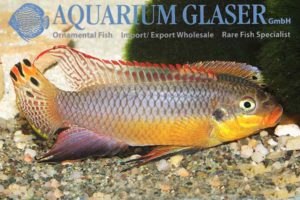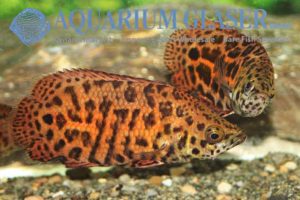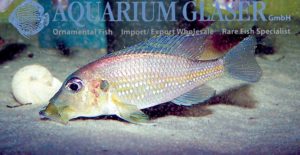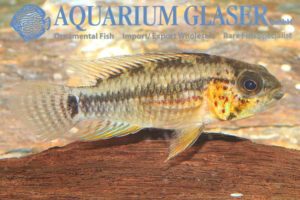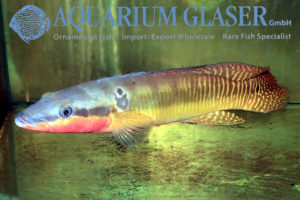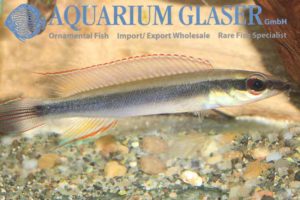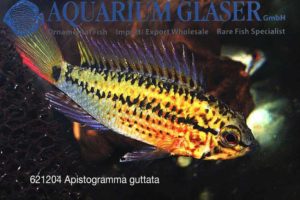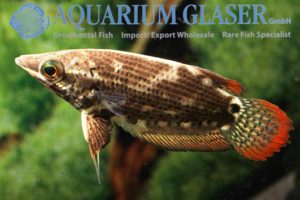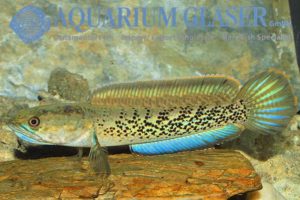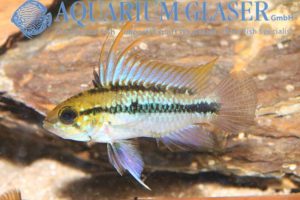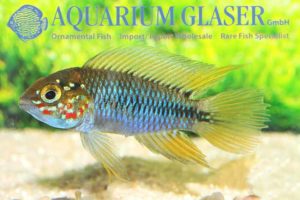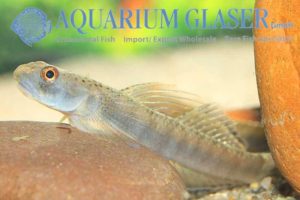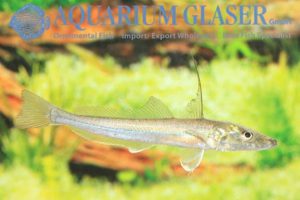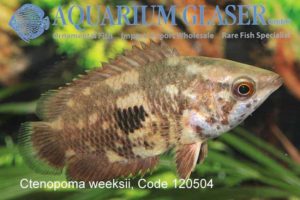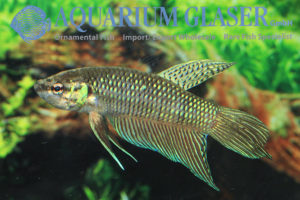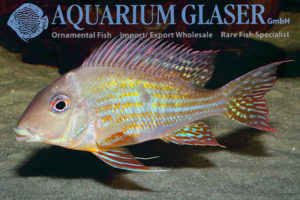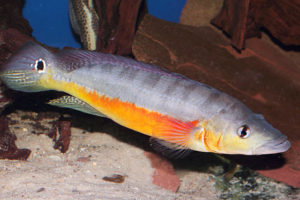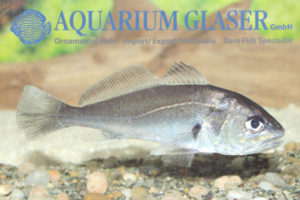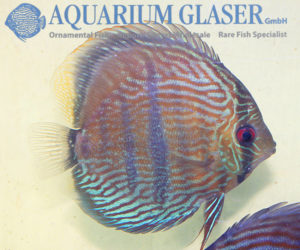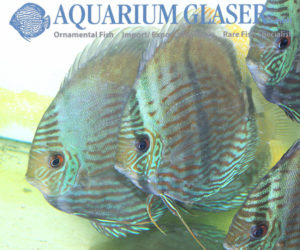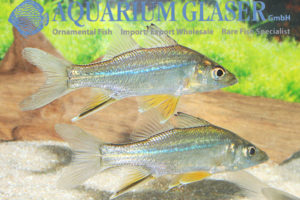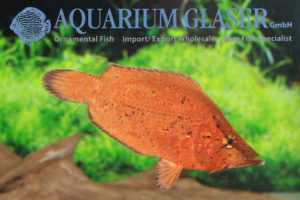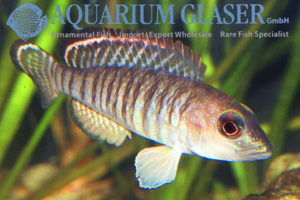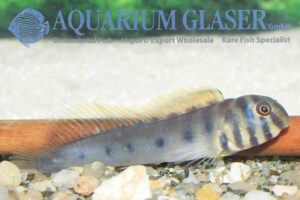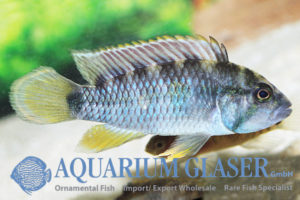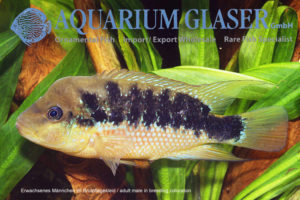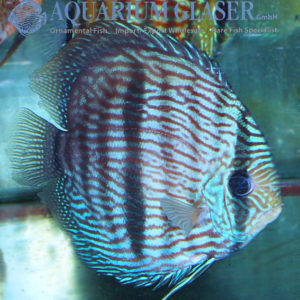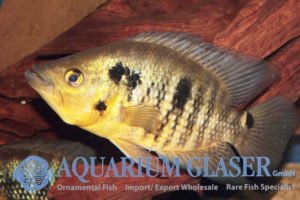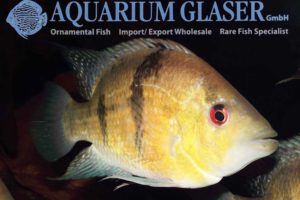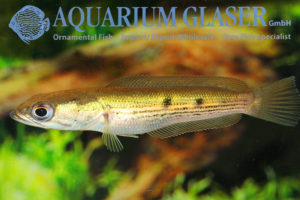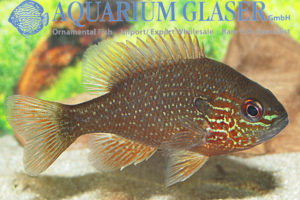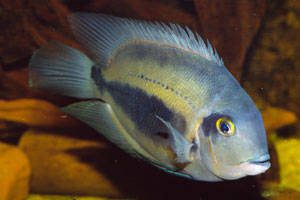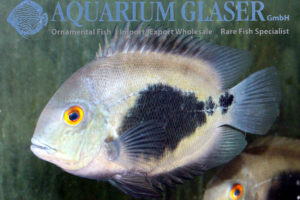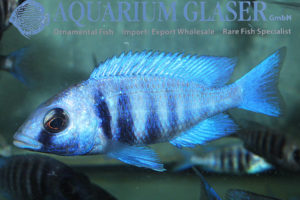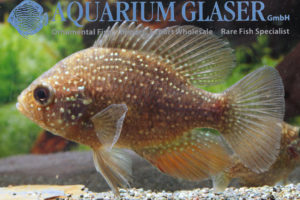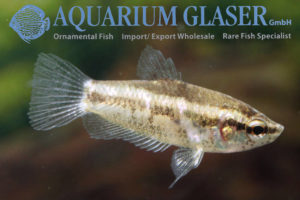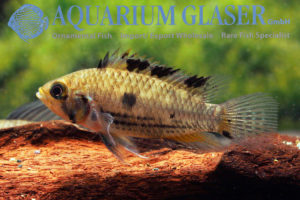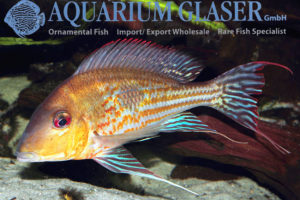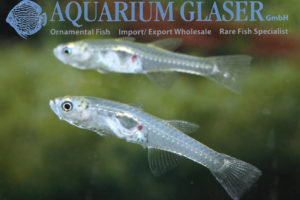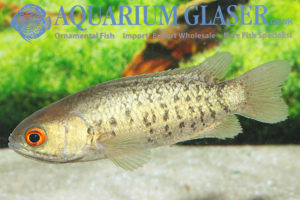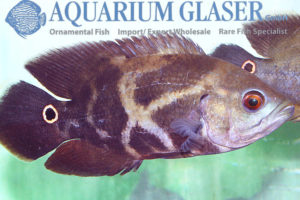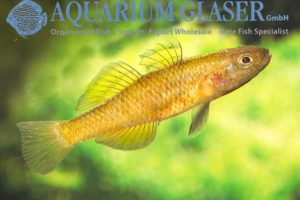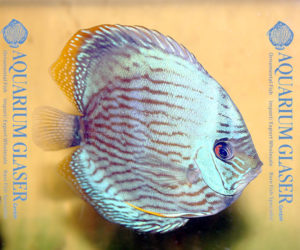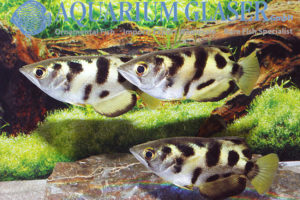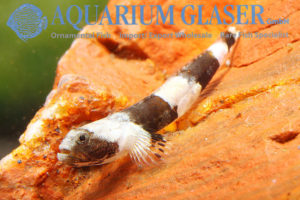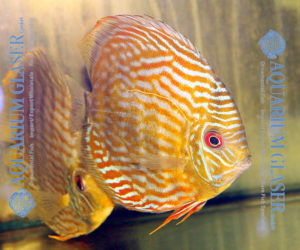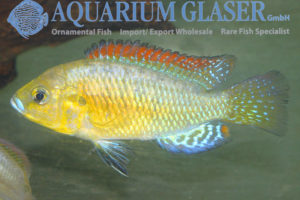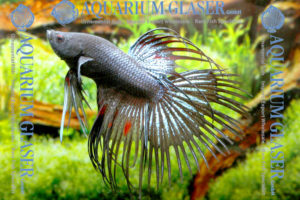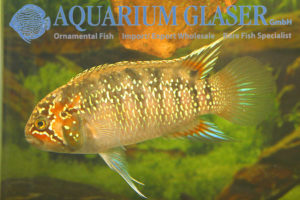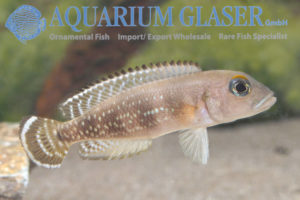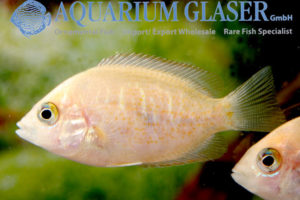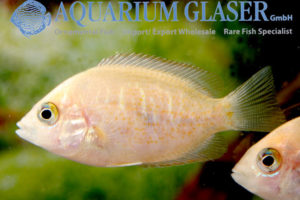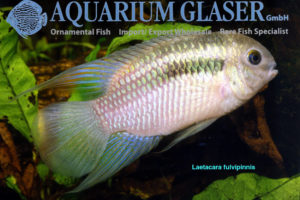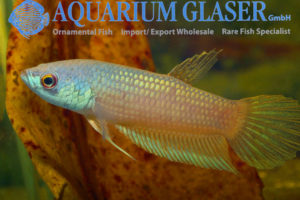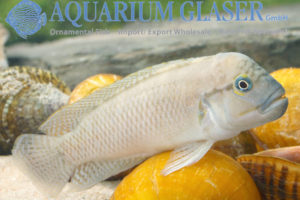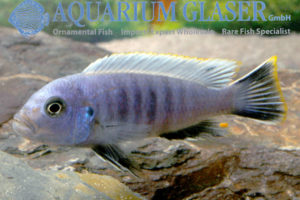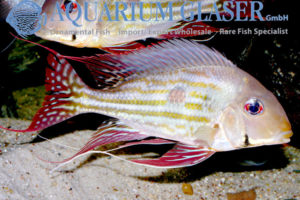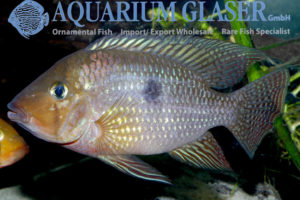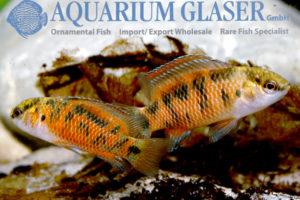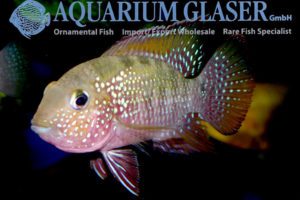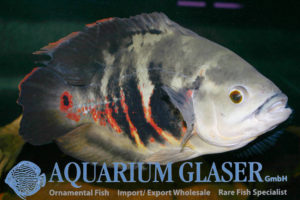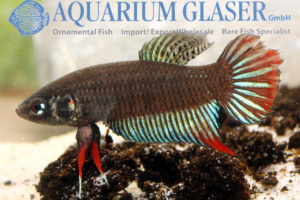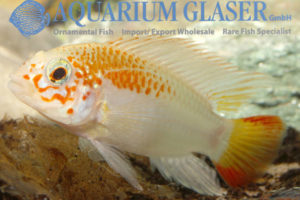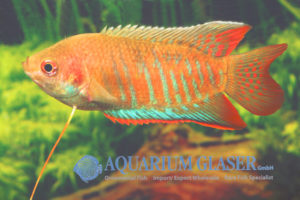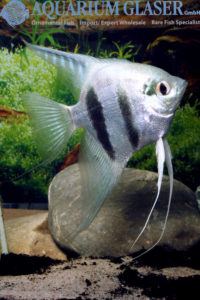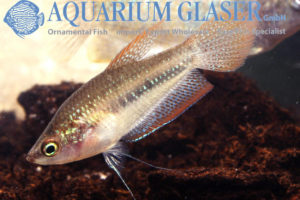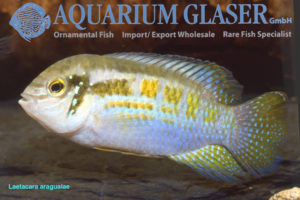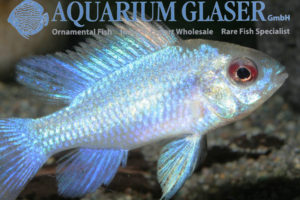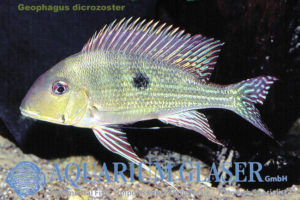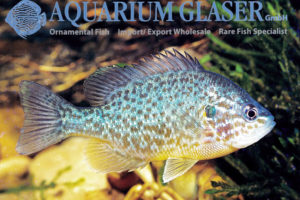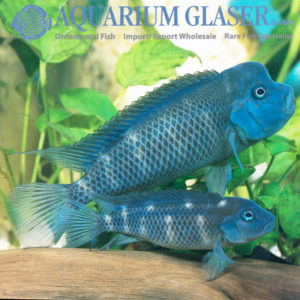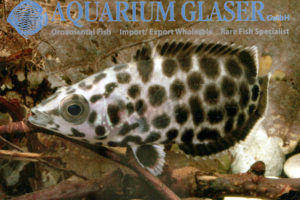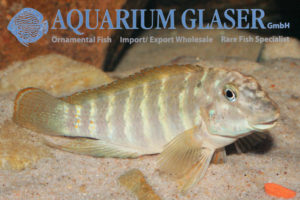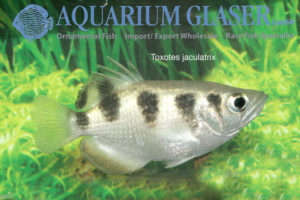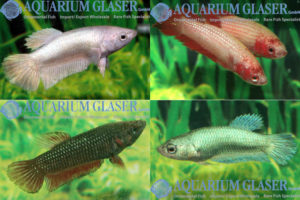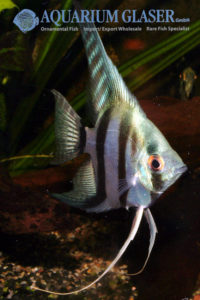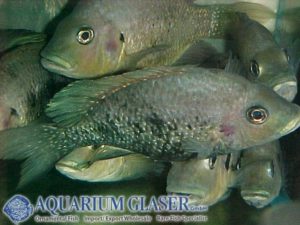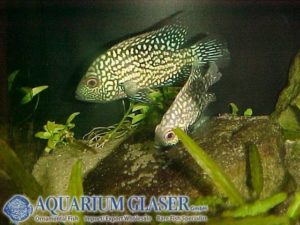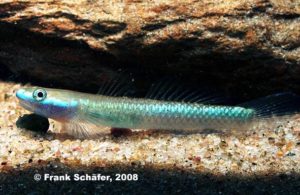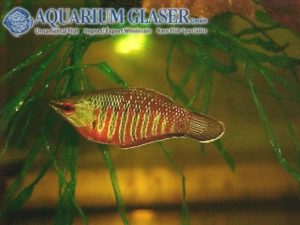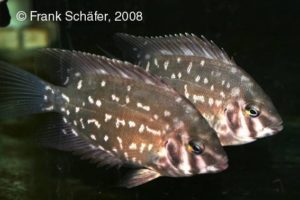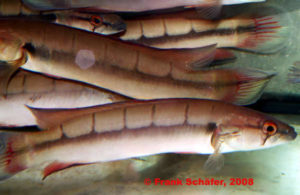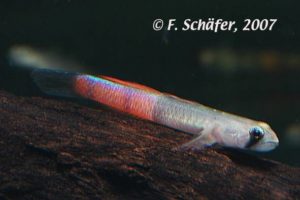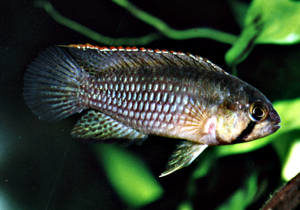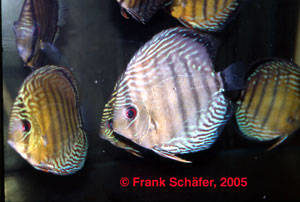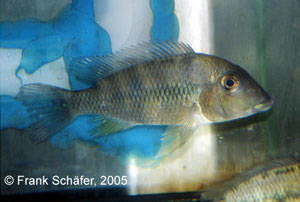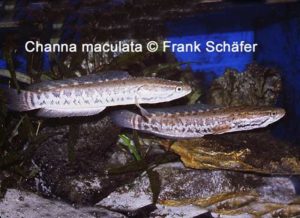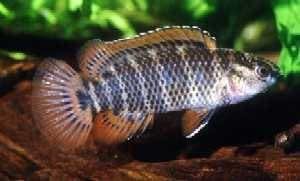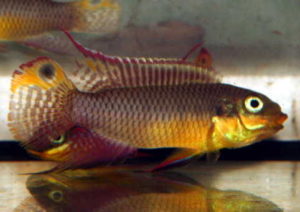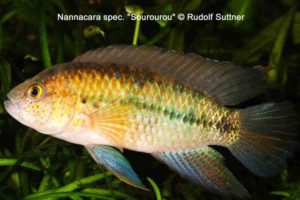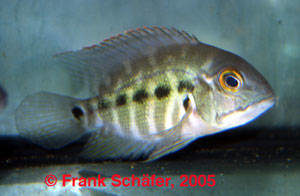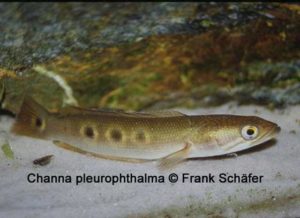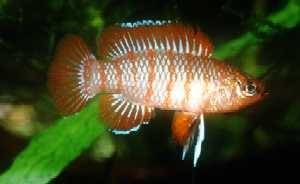This is another, extreme beautiful variety of that gorgeous dwarf cichlid from Western Africa: Pelvicachromis taeniatus “Nigeria Yellow”. Initially the animal originates from the surroundings of the Nigerian city of Lagos, but we have in stock fully grown adult bred ones. The bright golden breast and the very long finnage make Pelvicachromis taeniatus “Nigeria Yellow” […]
25. Perchlike fishes (861)
-
-
Ctenopoma acutirostre wild
It is been a quite long time since we had the last importation of this bushfish from the D. R. Congo. Immediately after their arrival the animals had an unbelievable strong coloration. Sadly it bleached out a bit over the time, but still looks great. Read more about the leopard bushfish here: http://www.aquariumglaser.de/en/archiv.php?news_id=140 For our […]
-
Gnathochromis permaxillaris arrived
This week we received bred specimens of this very rare cichlid from Lake Tanganjika. A breeding report can be found at http://www.aqualog.de/news/web3/3-7.pdf For our customers: the fish has code 520703 on our stocklist. Please note that we exclusively supply the wholesale trade. Lexicon: Gnathochromis: ancient Greek, means “jaw-chromis”, referring to the very special mouth structure. […]
-
Apistogramma sp. Assurini
Currently we received a new Apistogramma from Brazil, a close relative of the species known as A. sp. Xingu in the hobby. Like most Apistogramma, A. sp. Xingu, which has been imported in 1988 for the first time, has developed a number of varieties. Some of them appear within one population, others seem to represent […]
-
First import! Crenicichla zebrina arrived
This pike cichlid was discovered only in 2002 and described scientifically in 2008. It originates from the lower Ventuari river, the largest tributary of the upper Orinoco in Venezuela. The Ventuari is a clearwater river. Although the Ventuari river is rather good sampled, the describers of that unique species were not able to obtain more […]
-
Crenicichla cf. regani Orinoco
The pike cichlids (Crenicichla) are one of the world´s most specious genera of cichlid. Currently 85 species are accepted. Many of them grow larger than 20 cm but there are also dwarf species. The beautiful, slender Crenicichla regani, which is said in literature to grow to a maximum size of 15 cm (male) or 8 […]
-
Apistogramma guttata
Code: 621204
-
Ctenops nobilis
Chocolate gouramis are very beautiful, but demanding anabantoids. Thus they should be kept by experienced aquarists only. There are three genera of chocolate gourami, Sphaerichthys (four species), Parasphaerichthys (two species) and Ctenops (monotypical). The only species in Ctenops is nobilis, the Noble gourami from India. It represents the largest of all chocolate gouramis and can […]
-
Channa stewartii
Code: 409304
-
Apistogramma trifasciata
In case this dwarf cichlid would not exist it would be necessary to invent it for the aquarium hobby. Apistogramma trifasciata is an ideal aquarium inhabitant. The species stays small – males around 5 cm, females around 4 cm. It is completely undemanding regarding water chemistry – keeping and breeding is possible even in medium […]
-
Apistogramma borellii
Recently we received beautiful wild collected specimens of A. borellii from Paraguay. This species is an ideal aquarium fish. In contrast to many other species of the genus A. borellii is completely undemanding regarding water chemistry. Even in medium hard, slightly alcalic water the species thrives well and even breeds. The behaviour of A. borelli […]
-
Stiphodon sp. Spotted Head
Code: 456043
-
Sillaginopsis panijus
The difference between “foodfish” and “ornamental fish” is often hard to tell. For example, who in Europe would term the zebra barb (Danio rerio) a foodfish? Nevertheless hundreds of thousands of these tiny animals are collected daily in India, become dried and are sold as a spice. On the other hand young examples of attractive […]
-
Ctenopoma weeksii
For our customers: the fish have code 120504 on our stocklist.
-
Betta mahachaiensis
Code number: 377103 Photo: Frank Schäfer
-
Geophagus altifrons “Alenquer”
Code number: 675003 Photos: Thomas Weidner
-
Crenicichla vittata
Code number: 673612 Photos: Thomas Weidner
-
Plagioscion squamosissimus
Croakers, also called Drums (Sciaenidae) are a fish family that comprises about 290 species. Most of them are marine, but some occur exclusively in fresh water. In South America about 20 species and 4 genera are known to live in fresh water. The smallest among them becomes only 7 cm long (Pachypops pigmaeus), most become […]
-
Discus Heckel Cross
The term “discus Heckel cross” is given for fish with a broader central bar on the body, the so called “Heckel bar”. Despite this the fish are very different and probably also originate from different regions. Among them are real gems, some with a high degree of red body colouration. For our customers: the fish […]
-
Discus Heckel Blue Body Nhamunda
Currently we have beautiful, large Heckel discus from the Rio Nhamunda in stock. The characteristic feature of that variety is the bright blue sash-like band. For our customers: the fish have code 734095 on our stocklist. Please note that we exclusively supply the wholesale trade. Text & photo: Frank Schäfer
-
Centropomus unionensis
The snooks (Centropomus) are distributed in the New World; currently 12 species are recognized. Persons that are reminiscent of giant perches (Lates) by looking at snooks are not wrong: until quite recently the snooks and the giant perches were united in a single family, Centropomidae. We were now able to import a pretty species of […]
-
Monocirrhus polyacanthus
The Leaffish, Monocirrhus polyacanthus, belongs to the most astonishing species of freshwater fish at all. The species – the genus Monocirrhus is monotypical – is spread all over the Amazon basin. It is found in Bolivia, Brazil, Colombia, Peru, and Venezuela. Our imports usually come from Peru, so the current one does. The Leaffish belongs […]
-
Lamprologus signatus
This beautiful cichlid from Lake Tanganyika belongs to the dwarf cichlids. Males become around 5.5 cm, females around 3.5 cm long. At the first glimpse one would think that these tiny fish are “snail brooders”, e.g. that the females would spawn only in empty snail shells. However, this is not true. In their natural habitat […]
-
Omobranchus zebra
Omobranchus belongs to the Blenniidae family, most of which live in marine environments. Due to their funny behaviour and the generally easy keeping the blennies are favorite fish of the marine hobbyists. There are only very few species that settle permanently in fresh or brackish water. One of the latter is the pretty Omobranchus zebra, […]
-
Apistogramma panduro var. “Marsel”
We were able to import this new dwarf cichlid from Peru now. The fish is without any doubt a close relative of the species Apistogramma nijsseni, A. panduro and the still undescribed A. sp. “Inka II”. In contrast to these species the seam around the caudal fin in males is yellow instaed of red-orange. The […]
-
Cichlasoma istlanum
The large cichlids from Central America are a bit out of fashion currently. That is a sad thing, for hardly any other fish combines in such a perfect matter brillant coloration, personality and interesting behaviour. Of course these fish need large tanks and an equipment that fits their needs, but if these things are given […]
-
Discus champions on a visit
Once more our Japanese friend Mr Akira Ishinabe has placed his discus he displayed in the current discus championship in Duisburg in our facility to give them an opportuntity to rest a bit after the stress of the exhibition before they turn back home to Japan. His Green Wild was able to get the first […]
-
Caquetaia kraussii
In the wild, Caquataia kraussii is something like a million fish. There is literally no waterbody, may it be pond, lake, or river in the Llanos of Venezuela without this cichlid. So the cichlid enthusiast is a bit left alone with the question why it takes so long if one searches for this fish in […]
-
Caquetaia myersi
Caquetaia myersi belongs definetly to the real rarities in the aquaria of the world. The main reason for this is the fact that it occurs in the wild far from the usual collecting sites in Colombia. What makes fishing in those areas even more difficult is the presence of guerilla which has quite different interests […]
-
Channa pleurophthalma
Currently we have charming juveniles (4-6 cm long) of Channa pleurophthalma in stock. Channa pleurophthalma can reach a maximum length of about 40 cm and is one of the most beautiful species in the genus. It is restricted to the great Sunda islands Sumatra and Borneo. In contrast to most other snakeheads this species swims […]
-
Lepomis megalotis
Sunfishes belong to the most colourful species of coldwater fish. The most widespread species in the hobby is Lepomis gibbosus, but the genus comprises not less than 12 species. Lepomis megalotis is native from NE-Mexico to the Great Lakes in the US and is additionally introduced in many countries. Up to six subspecies have been […]
-
Uaru amphiacanthoides
This large cichlid, which can grow up to 30 cm in length, has a wide distribution throughout South America. Despite its modest colouration and considerable size this species is well known in the fish tanks of the aquarium hobbyist, mainly because of the interesting behaviour and the lack of aggressiveness against fellow tank mates. Especially […]
-
Uaru amphiacanthoides
Extremely beautiful, fully grown specimens of this amazonian species of cichlid reached us now from Brazil. Uaru are peaceful fishes that can be best compared with discus regarding demands on water quality and temperature. However, Uaru are more or less specialized herbivorous fishes. For our customers: the fish have code 688517 on our stocklist. Please […]
-
Placidochromis sp. “Phenochilus Tanzania”
The generic placement of the Malawian cichlids formerly lumped in the genus Haplochromis depend on their melanin pattern, eg the black markings in the basic coloration. Sadly the melanin pattern is not recognisable in the only existing type specimen of Haplochromis phenochilus, which was described in 1935; thus its correct generic placement remains unknown until […]
-
Enneacanthus gloriosus
The Bluespotted Sunfish (Enneacanthus gloriosus) is a coldwater fish and a real oldtimer among aquarium fish. Aquarists used to name the up to 7.5 cm long fish “working class discus”, due to its brillant colours and the nice behaviour. However, it was never as expensive as the discus. Bluespotted Sunfish occur in nature along the […]
-
Parasphaerichtys lineatus
Once more we have the smallest anabatoid fish of the world in stock: Parasphaerichthys ocellatus, the mini chocolate gorami. This tiny species hardly reaches 2 cm in length. In contrast to all other chocolate gouramis this is a bubblenester builder (all others are mouthbrooders) and should be kept and bred in harder, slightly alcalic water […]
-
Apistogramma cactuoides WILD
Some species of fish are very popular in the aquarium hobby. Many of them are kept only as sports or breeding forms that do not exist in the wild and most aquarists are completely unaware how the wild form looks like. One of these species is the very popular dwarf cichlid Apistogramma cacatuoides. The species […]
-
Geophagus megasema
There is almost no chance that commercial importations of wild collected Geophagus megasema will ever appear. So it is very welcome that travelling aquarium enthusiast collect such species in areas that are ignored by professional fish collectors and bring them home alive, which makes it possible to develope a captive bred stock. Geophagus megasema was […]
-
Gobiopterus chuno
Glass perches and glass catfish are well known and common aquarium fish. But do you know glass gobies, too? The members of the genus Gobiopterus (there are so far 9 known species) are tiny freshwater gobies. They reach only 2-3 cm length and are so transparent that the observer can see how a food item […]
-
Anabas cf. macrocephalus
The Climbing Perches (Anabas) are no popular aquarium fish at all. Scientists also do not work on them and so the systematics of the genus are quite unclear. Members of the genus can be found all over the tropical and subtropical areas of South and Southeast Asia. However, it often remains unclear wether the fish […]
-
Astronotus ocellatus wild, Colombia
The Oscar, Astronotus ocellatus, belongs to the most popular species among the large cichlids. It was imported to Europe in 1929 for the first time. In Asia, many different sports have been bred since. However, the wild ancestors of the Oscar remain somewhat mysterious and little understood. Until recently, only one or two species were […]
-
Mugilogobius rexi
This small, yellow goby is a free swimming species, in contrast to most of the other gobies. Maximum length is about 4-5 cm. Territorial males become bright yellow and also develope larger fins with dark bands. Females are much paler in coloration and have translucent fins. The species is restrictet to Sulawesi and even on […]
-
Discus Heckel / Jatapu
The series of astonishing wild collected discus we are able to offer right now does not break off. Besides the wonderful Royal Blue which we introduced to you last week, we also have excellent Heckel blue-head said to come the Jatapu river. This branch of the Amazon river has an unique mix of fauna found […]
-
Toxotes sp. New!
A new species of Archerfish! Recently we received a shipment containing archerfishes (Toxotes) from Thailand. Most of the shipment were T. jaculatrix (see http://www.aquariumglaser.de/en/toxotes-jaculatrix_en_1076.html) and some T. chatareus (see http://www.aquariumglaser.de/en/toxotes-chatareus_en_1044.html). But a closer look showed also four specimens of an unique colored archerfish, which we have never seen so far and which fits to none […]
-
Schismatogobius ampluvinculus
We received for the first time now this cute goby from Taiwan. Especially when it is in the right mood it looks extremely pretty due to its contrasting black-and-white coloration. One of the generic characteristics of Schismatogobius is the fact that they have an individual coloration: there are not even two specimens with the exact […]
-
Discus Royal Blue Novo Ariguana
Yesterday (2.2.) we received breathtaking beautiful large wild collected discus called Discus Royal Blue Novo Ariguana. All insiders will understand that the fish do not show all of their beauty today, but even what they show is amazing! Text & photo: Frank Schäfer
-
Pseudocrenilabrus multicolor victoriae
This extreme beautiful small cichlid has changed its name quite often. Initially it was introduced to the hobby under the name Pseudocrenilabrus philander dispersus. The natural distribution area of this subspecies is Uganda. Only bred specimens are traded. The fish are agamous maternal mouthbrooders, which means that the males and the females do not build […]
-
Betta splendens Crowntail Black
Crowntail bettas become more and more popular. Although they exist probably since the 1960ies and although the gene for “crowntail” is dominant, these fishes became popular in Europe and the US only in the beginning of this millenium.The exact origin of this cultivated form is not documented in literature. The first citable appearance we know […]
-
Nannacara adoketa 2
This cichlid originates from a quite small area in the middle course of the Rio Negro in Brazil. It was discovered as late as 1993 and for a long time most aquarium enthusiasts only could dream off it. The very few imported specimens were mostly sold to Japan. They were very expensive, but nevertheless found […]
-
Neolamprologus meeli
Among the snail-dwelling cichlids of Lake Tanganyika are some species that look very much alike and in some cases it remains still unclear whether the scientific name applied on them is correct or not. Neolamprologus meeli has been described in 1948 by Max Poll from a place near Katibili which belongs to the Congolese part […]
-
Etroplus maculatus
The Indian cichlid, Etroplus maculatus, is a very popular aquarium fish and never disappeared after its first importation again. Recent research suggests that Etroplus is not a close relative of the cichlid family, but rather of the damselfishes (Pomacentridae). However that does not mean anything for the hobby. Etroplus maculatus can be kept and bred […]
-
Etroplus maculatus “Gold-Blue”
The Indian cichlid, Etroplus maculatus, is a very popular aquarium fish and never disappeared after its first importation again. Recent research suggests that Etroplus is not a close relative of the cichlid family, but rather of the damselfishes (Pomacentridae). However that does not mean anything for the hobby. Etroplus maculatus can be kept and bred […]
-
Laetacara araguaiae
Laetacara sp. „Buckelkopf“ described scientifically. Laetacara sp. „Buckelkopf“ is known in the hobby for many years already. The somewhat unusal common name (the German word „Buckelkopf“ means „humphead“) derives from the feature developed by some very old males, but this happens rather seldom. It is a typical dwarf cichlid, the males grow to a length […]
-
Betta kuehnei
The mouthbrooding fighting fishes of the Betta pugnax group are wideley spread over Thailand, Malaysia and Indonesia. The most currently described species is Betta kuehnei from the northernmost Province Kelantan of Malaysia and the southernmost parts of Thailand. The species has been discovered by the travelling aquarist Jens Kühne and introduced in the hobby as […]
-
Telmatochromis temporalis
Snail-cichlids are a specialty of Lake Tanganyika. Of course also other places on earth exist where empty shells of snails are used by fish for hiding or breeding. But nowhere else than in Lake Tanganyika are so many specialized species. In Lake Tanganyika real fields of empty snail-shells exist. Empty shells that lie here and […]
-
Cynotilapia axelrodi
Currently we have received beautiful C. axelrodi from a breeder. The animals are full in colour and about 4-6 cm long. Maximum length for this species is given around 9 cm. Cynotilapia are typical mbuna cichlids. They differ from the closely related Maylandia (the zebras) by the dentition. Keeping is identical, which means they need […]
-
Geophagus winemilleri
The main distribution of Geophagus winemilleri is the southern part of Venezuela. Nevertheless most imports come from Brazil, because the species also occurs in the Rio Negro. G. winemilleri becomes often confused with G. proximus and a second, still undescribed or unidentified species. However, G. winemilleri can be identified by the dark spot on the […]
-
Geophagus sp. „Rio Sao Francisco“
This pearl cichlid from the Rio São Francisco can reach a total length of about 25 cm and thus should be kept in relatively large aquaria of 400 litres and more. Although pearl cichlids are known to be relatively aggressive this particular species is quite peaceful if the tank is large enough. Even when taking […]
-
Badis “Piebald”
Currently among the specimens of Badis badis bred by commercial breeders relatively often aberrant specimens are found. A closer look on these fishes reveils that besides the unusual irregular black pattern the basic body colour is a deep red. There can be no doubt that these animals are hybrids. Quite recently only one species with […]
-
Bujurquina oenolaemus
Bujurquina oenolaemus: This very pretty species of Bujurquina originates from Bolivia and was described scientifically as early as 1987 by Kullander. It took almost 20 years before the first living specimens were brought to Austria, Switzerland and Germany by travelling aquarists. Soon after breeding was successful and so the species was spread in the hobby. […]
-
Astronotus sp. „Bahia Red“
Sadly it was not possible to research if this Astronotus really was collected in the Brazil state of Bahia. Currently no scientific reports of the occurence of the genus in Bahia are known. So we have to leave the question open, if this population was brought to Bahia as a food fish or if they […]
-
Betta siamorientalis
(formerly: Betta cf. imbellis „Vietnam Black“). We import from Vietnam a pretty wild collected Betta for some time now. The exact determination of that species proofed to be quite complicated. There are four scientifically described species from this complex: Betta imbellis, B. smaragdina, B. splendens, and B. stiktos. An additional species is already known in […]
-
Apistogramma viejita GOLD
For the first time we can offer now this beautiful dwarf cichlid in a golden sport. This sport does not occur in nature. The contrasting golden and red colours make the fish extremely attractive. As Apistogramma viejita originates from Colombia it should be kept at higher temperatures as usual, eg 26 – 28°C. Water should […]
-
Colisa cf. fasciata
The northern states of India are hardly researched in respect of the fishes. From the state of Manipur we currently received exceptionally colorful gouramis of the genus Colisa, which represent a species new to science. They are without doubt close relatives of the species Colisa fasciata, C. bejeus, and C. labiosa, but differ from all […]
-
Blue Angel Showsize
In January 2009 we presented to you the new blue dwarf angel (http://www.aquarium-glaser.de/en/pterophyllum-scalare-blauer-zwerg–blue-dwarf_en_1071.html). In the meantime the breeders were pretty active and crossed the blue dwarfs onother strains of angels. So now we are able to supply also blue angels in showsize, which are almost as big as angels of other colour varieties. Text & […]
-
Trichopsis schalleri „Vietnam“
The genus Trichopsis (Croaking gouramis) currently comprises three accepted species: T. vittata, T. pumila, and T. schalleri. This hardly reflects the reality. Especially T. vittata seems to be catch-all species and represents a number of undescribed species. Trichopsis schalleri was known so far from Thailand only. We now get this pretty species also from Vietnam. […]
-
Laetacara araguaiae, Laetacara fulvipinnis
Laetacara sp. „Buckelkopf“ described scientifically Laetacara sp. „Buckelkopf“ is known in the hobby for many years already. The somewhat unusal common name (the German word „Buckelkopf“ means „humphead“) derives from the feature developed by some very old males, but this happens rather seldom. It is a typical dwarf cichlid, the males grow to a length […]
-
Mikrogeophagus ramirezi „Electric Blue“
The Ram is one of the most beautiful aquarium fishes. The wild Ram originates from the llanos of the Orinoco. The newest sport of this dwarf cichlids is blue all over the body. It is virtually impossible to illustrate this very special colour in a high resolution picture. Only reducing the resolution brings the effect […]
-
Geophagus dicrozoster and G. abalios
The beautiful eartheaters of the Geophagus-surinamensis relationship are among the most colorful cichlids, shining in all colours of the rainbow. There are numerous species and some of them even have colour varieties in different river systems. As these are currently not recognized by scientists, we help ourselves in adding the river´s name behind the scientific […]
-
Lepomis gibbosus
The pumpkinseed (Lepomis gibbosus) is one of the most beautiful coldwater fishes. Moreover it has a very interesting behaviour. The species originates from central parts of the North American continent. The continental climate (hot summers, cold winters) makes the pumkinseed a hardy fish and so it was transferred by humans to many regions as a […]
-
Just in: Steatocranus!
Adult pair of S. casuarius. Photo: B. Migge / Aqualog Archieves The humphead cichlids of the genus Steatocranus are among the most intersting cichlids of Africa. They are highly adapted to current water – in nature they live near rapids on rocky ground. So they have reduced their swimming bladder and are not able anymore […]
-
Ctenopoma acutirostre Leopard babies!
Among the most beautiful anabantoids or labyrinth fish from Africa is Ctenopoma acutirostre, the Leopard bushfish. It can become 15-20 cm long. Its natural habitat is the Congo. It is collected there for the ornamental fish trade in the Stanley Pool region. Here the fish live under the swimming meadows of the water hyacinth (Eichhornia […]
-
Eretmodus cyanostictus “Makombe”
Actually we can offer very pretty Tanganyika Clowns, Eretmodus cyanostictus, from Makombe. Like so many other cichlids from the lake they have developed a lot of different geographical varieties. Eretmodus are highly specialized fishes. In the wild they live in the very shallow water of the shore. Here, in the surf, they feed on aufwuchs. […]
-
Toxotes jaculatrix
Seven species of Archerfishes (Toxotes) are known. Three of them (T. lorentzi and T. kimberleyensis from Australia and T. microlepis from South East Asia) are usually found in fresh water. Two are practically unknown, at least they have not been kept in aquaria so far: T. blythi from Burma and T. oligolepis from the Moluccas. […]
-
Betta splendens
We have a new supplier for fighting fish (Betta splendens). Besides the amazing males (which we will introduce to you detailed in the near future) there are also wonderful females. Text & Fotos: Frank Schäfer
-
Pterophyllum scalare Blue Dwarf
In 1949 Werner Ladiges mentions a blue dwarf angel (Pterophyllum scalare) that appeared by chance (problably by mutation) in a large breeding stock before WW2. Beside its unique blue coloration a characteristicly feature of these fishes was their small adult size. They never grew bigger than 5 cm body height. Although this stock survived WW2 […]
-
Ptychochromis oligacanthus
They come from the crater lake Bempazawa on the island Nosy Be nearby Madagascar and we have few of them available for first time: Ptychochromis oligacanthus “Bempazawa”. Their final length is more than 20 cm, but with their current size of about 15cm, they already reached sexually maturity. They have no special demands for food […]
-
Herichthys sp. BLUE-GALAXY
(Aug.6th 2008) A brand new star is born: Herichthys sp. Blue-Galaxy. We are proud to be able to supply limited numbers of this this beautiful breeding form for the first time. They are pubescent in a size of 6-8cm, which they have successfully demonstrated in a tank in our office. Since they should not get […]
-
Stiphodon semoni
(23.Aug.2008) From Indonesia we received this beautiful neon-blue goby. Stiphodon semoni grows up to 4-5cm and was several times imported under the wrong name Sthiphodon elegans. Its habitats are fast floating hillstreams with rocky ground. It is found in Indonesia, the Philippines, New Guniea and the Solomon Islands. The nourishment for this item is easy: […]
-
Sphaerichthys vaillanti
(25.April 2008) A real beauty made by nature is currently available: Sphaerichthys vaillanti. This fish, which is called red chocolate gourami, is without any doubt the best looking one of all 4 Sphaerichthys members. The water should be soft, not too cold (25-29°C) with a low pH (4,5-6,5). If you offer these water parameters, you […]
-
Uaru fernandezyepezi
(9.April 2008)For the first time we can offer some offspring of Uaru fernandezyepezi. The home of this extremely rare cichlid is in the border area of Colombia and Venezuela, where they occur in the area of the Rio Atabapo. From there origin some challenging fishes such the Altum-Angels. Their requirements are similar, the water hardness […]
-
Crenicichla sp.ATABAPO FIRE Venezuela
Last week we got a very small amount of one of the most beautiful pikecichlids: Crenicichla sp.ATABAPO FIRE Venezuela. Sorry for the bad picture, but it was taken directly in a tank in our facility, not in a photo-tank. But it shows how nice this fish is!
-
Sicyopus zosterophorum
Actually in small numbers available: Sicyopus zosterophorum. This loach is coming from the Pinang river in the western part of Sumatra. Until now they were not imported in big numbers, so we do not know much about keeping them. But an experienced hobbyist should not be faced with big problems with keeoping this item.
-
Nannacara sp. Essequibo
This fish was caught in October 2001 in a blackwater-river nearby Rockstone/Guyana. It is a peaceful fish which only grows up to 60mm. The males are more elongate than the females and have clearly visible spots in the dorsal and caudal fins. Water of following parameters was used for breeding and keeping them: 5°dGH, pH […]
-
Diskus „Wild Lago Inanum“
This very beautiful discus fish is traded as well under the name „Semi Royal Blue“. Wild caught discus fish are just beautiful! It is remarkable that still new wild type varieties are found and imported. Wild caught discus fish will not be feeling themselves well if not kept under optimal conditions. This malcontent will be […]
-
Geophagus crassilabris
Very large animals, up to 20 cm, came to us from Colombia. These beautiful fish came as well from the Rio Chacu. These eartheaters live in nature in a habitat of moderately flowing streams and rivers. Remarkably for this group of eartheaters is the way they breed their eggs, not as normally in the throat […]
-
Channa maculata
Channa maculata is a snakehead which origins of the border area of China and Viet Nam. It is there very common and offered on markets in large numbers, naturally as a food fish. In their habitat C. maculata lives in ponds, lakes and ditches, usually over sandy or muddy bottoms. With a final size of […]
-
Badis corycaeus (formely: sp. Putao)
This new, brown-red Badis was imported from the borderland of Myanmar and China. They can can be kept even in cooler temperatures and are easily satisfied. Also bred ones are already available. (Photos & Text D. Bork)
-
Pelvicachromis taeniatus „Lokundje“
From Pelvicachromis taeniatus are numerous variants and local forms existing in the western parts of Africa. One of the most beautiful variants is surely Pelvicachromis taeniatus „Lokundje “(a river in the south of Cameroon). At the moment we can offer very beautiful breds from the same breeder as the already introduced Apistogramma agassizi „Fire Red […]
-
Nannacara spec. -Sourourou-
From the Crique Sourourou in French Guyana originates this beautiful new Nannacara variant. We are pleased to be able to offer some offspring to you. According to information of an experienced Nannacara specialist their maintenance is unproblematic, even in middle hard water. The breed however succeeds only in soft and sour water according to their […]
-
Hoplarchus psittacus
This, by specialised hobbyists of large South American cichlid, well known species is only very rarely offered to the public. Our animals were imported from Columbia. The best way to take good care of these beautiful cichlids, which can grow up to 40 cm, is to keep them in large fish tanks with plenty of […]
-
Channa pleurophthalma
Channa pleurophthalma (Ocellated Snakehead) inhabit the lakes and rivers of southeastern Sumatra; Kapuas and Barito basins of Kalimantan. The colouring which can be seen on the young fish illustrated here changes with increasing age to iridescent, metallic blue. C. pleurophthalma can reach an overall length of 40 cm and requires a large aquarium (> 150cm). […]
-
Dario dario
This species, which became well-known as Badis sp. SCARLET is still enjoying great popularity. This dwarf badis can be kept very well along with dwarf rasboras. It is is quite easy to keep and to breed, which was succesfully done several times already. (Photos & Text Dieter Bork)
Discus season!
The season for wild collected discus is running now and we can offer a great number of marvellous animals, for example from the Nhamunda-Maracanha region (please, see also http://www.aquariumglaser.de/en/fish-archive/discus-en/Diskus_Nhamunda_rose__en/, http://www.aquariumglaser.de/en/news/Nice_Discus_wildcaught_available__en/, http://www.aquariumglaser.de/en/fish-archive/discus-en/Diskus_Nhamunda_rose_en/ and http://www.aquariumglaser.de/en/news/Discus_Royal_Blue_Nhamunda_Maracanha_en/):

731306 Blue Nhamunda Maracanha

731356 Royal Blue Nhamunda Maracanha

731365 Semi-Royal Blue Nhamunda Maracanha

731405 Rose Nhamunda Maracanha
For the first time we have wonderful Discus Caiambe in stock. Although these are wild collected fish, they cannot be assigned properly to the Green or the Brown/Blue Discus. Some specimens have red dots on the flanks, a phenomenon that can be found in Green discus also.

732505 Caiambe

732505 Caiambe

732515 Caiambe Few Spot
And last but not least we also have pretty discus from the Rio Aripuana in a semi-royal selection and a good size in stock.

735995 Semi-Royal Blue Aripuana
(to be continued)
Text & photos: Frank Schäfer
Discus Royal Blue Nhamunda Maracanha

And here comes another fantastic wild collected Discus. Nhamunda discus have some peculiarities. First of all: many have a high content of red colors in their basic coloration. Second: in Nhamunda discus exists a sexual dichromatism and dimorphism. Royal Blue are almost exclusively males, females are usually categorized as “Brown” or “Blue”. Females furthermore have a more roundish, disc-shaped body and males are rather oval-shaped.
For our customers: the fish have code 731355 on our stocklist. Please note that we exclusively supply the wholesale market.
Text & photos: Frank Schäfer
New Names for Goldseam Cichlid and Green Terror

The Goldseam Cichlid from Peru and the Green Terror from Ecuador belong to the most popular cichlids for decades already. The splendid colours, the easy breeding and the fascinating behaviour are responsible for this popularity.
Nevertheless is was unclear for a long time how these fish should be placed systematically. Hobbyists thought that both belong to two different, though closely related species, a point of view that was adopted by most taxonomists, too. So the Goldseam was called Aequidens rivulatus and the Green Terror Aequidens sp. aff. rivulatus (see for example Aqualog Southamerican Cichlids III).

Now recent papers present the results of new investigations, which included not only morphological but also genetical methods. So it was found that the Green Terror belongs really to a new and distinct species. Along with the Goldseam and some other close relatives (Aequidens biseriatus, A. coeruleopunctatus, A. latifrons, A. pulcher, A. sapayensis) he was transferred in the new genus Andinoacara and was named Andinoacara stalsbergi. The Goldseam, however, now should be called Andinoacara rivulatus.
For our customers: A. rivulatus has code 610003, A. stalsbergi 610811 on our stocklist. Please note that we exclusively supply the wholesale market.
Lexicon: Aequidens: Latin, means “with equal tooth”. This refers to the set of teeth. sp. aff.: Latin, abbreviation of “species affinis”, which means “similar species”. rivulatus: Latin, means “originating from a brook”. stalsbergi: in honour of Alf Stalsberg. Andinoacara: means “Acara from the Andes”. Acara is another genus of cichlid.
Literature: Musilová, Z., Schindler, I. und W. Staeck (2009): Description of Andinoacara stalsbergi sp. n. (Teleostei: Cichlidae: Cichlasomatini) from Pacific coastal rivers in Peru, and annotations on the phylogeny of the genus. Vertebrate Zoology 59 (2): 131-141.
Text: Frank Schäfer, photos: Aqualog archieves and Frank Schäfer
Wonderful German Bred South American Cichlids
Some of the larger cichlids of South American belong to the most beautiful freshwater fish at all. We have recently obtained four species of them, all top German bred quality.

Geophagus winemilleri, a breathtaking species from Venezuela, belonging to the Gephagus-surinamensis-group, code 682601

Bujurquina oenolaemus, a splendid Bolivian, a mouthbrooding species from the Aequidens relationship, code 634551

Geophagus sp. Rio Sao Franzisco, an openbrooder that belongs to the Geophagus brasiliensis group and developes much red coloration, code 682131

Astronotus ocellatus “Bahia”, a wild type of oskar which has deep red colours in the belly region when adult, code 633281
More details on those wonderful fish will be availble soon in our fish archieves.
Text: Frank Schäfer, photos: Thomas Weidner
Wonderful Golden Rams!

We currently have an extraordinary good and healthy stock of Golden Rams, bred in Germany. They have a perfect size and are highly recommended for anybody who wants to try these beauties for the first time.

For our customers: the fish have code 686802 on our stocklist. Please note that we exclusively supply the wholesale market.
Text & Photos: Frank Schäfer
Nice Discus wildcaught available!
Discus wild ROYAL-BLUE Rio NHAMUNDA

Discus wild HECKEL CROSS Rio NHAMUNDA

Discus wild HECKEL CROSS Rio JATAPUA

An brand new snakehead!
 First time imported: a brand new and undescribed snakehead from India; Channa sp. . So far we only know that this fish belongs to the same group as Channa bleheri. Therefore we believe that the max.size will be around 12cm. As soon as we will get more information about them , we will share with you!
First time imported: a brand new and undescribed snakehead from India; Channa sp. . So far we only know that this fish belongs to the same group as Channa bleheri. Therefore we believe that the max.size will be around 12cm. As soon as we will get more information about them , we will share with you!





